10 Savory Herbs to Add to Your Garden This Spring
Tips from 1943 for growing 10 fresh herbs — and how to use them.
—
10 Savory Herbs Grow in My Garden
Originally published in The Country Gentleman, March 1, 1943
Cooking would be less of an adventure without my “yarb patch” and its 10 savory herbs I’ve found most satisfactory. Your own choice, after experiment, may not coincide exactly with mine, but you’ll find herbs are not hard to raise. They thrive on average to poor soil; many are drought-resistant and most of them are pest and disease resistant. They will need at least six hours of sun a day and many do best in full sun. Many can be grown from seed, but all may be purchased as started plants from reliable nurseries.
From one to three plants of any herb will be enough for the average family, except perhaps dill and caraway.
PARSLEY, of course, comes first. It’s a biennial, but since it is not a hardy one in my climate — Iowa — I sow fresh seed every year. In the fall I transfer a plant or two to 6-inch pots in a sandy soil mixture and cut them back rather severely. They prefer a sunny south window in a cool room and, watered well, supply all the fresh parsley our family can use.
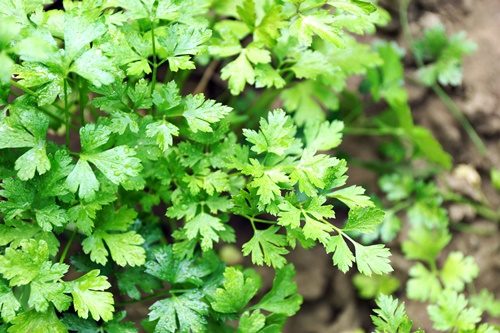
Good hashed brown potatoes are even better with 1/2 cup of chopped parsley for 6 servings. It adds color and flavor to buttered whole carrots and may be used generously in stews and vegetable soup. Sprinkled on top of potato or bean soup, it’s good to look at and better to taste.
CHIVES may be started from seed, but bunches or pots of chives are not expensive and can be divided into many little plants. Three or four bulblets should be set together, the groups spaced 7 or 8 inches apart. The plants mingle well with other perennials in the flowerbed where their fluffy lavender blooms are interesting in spring and the slender leaves make a green clump until frost.
The chopped-up leaves lend a whisper of onion flavor that blends well with other seasonings. Men will like chives even better than parsley with buttered new potatoes. Chives give a lift to fried potatoes, cottage cheese, vegetable salads, scrambled eggs, and omelettes. Chive butter is made and used the same way as parsley butter.
SAGE is a pretty perennial, growing three or four feet high, with gray-green pebbled leaves which remain fresh until a hard frost. Each plant needs about 2 square feet of space. Sage is almost a must for pork sausage and poultry stuffing. I use 1/2 teaspoon of dried leaves for 1 pound of ground pork and 1 teaspoon for 2 cups of soft bread crumbs. Also, my family likes sage tea made by mixing1/4 teaspoon of sage with hot milk.
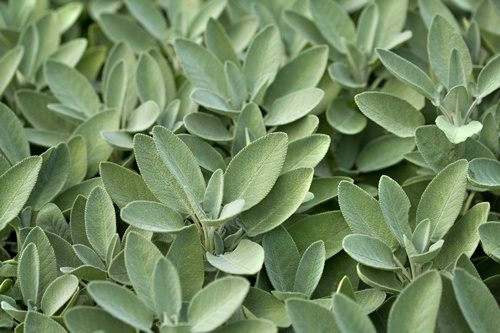
THYME is a dainty-leaved little perennial growing 8 to 10 inches high. It seems to have an affinity for meats and meat dishes, so we sprinkle a little — say a tablespoon — of fresh leaves or a teaspoon of dried leaves over a 4- or 5-pound pork roast. Or we roll “pencils” of salt pork in dried thyme, salt and pepper and insert them, with a little onion, in slashes made every 2 to 3 inches in veal or pot roast. Creamed chicken is special with 1/4 teaspoon of dried thyme added to 6 servings. The same amount improves creamed chipped beef. A pound of ground beef with 1/4 teaspoon of dried thyme makes delicious hamburgers. Grape jelly flavored with thyme is a pleasing accompaniment for any kind of meat.
SWEET MARJORAM is really a perennial but not very hardy in cold climates, so I raise it in the garden in the summer and bring some of the small plants which have not yet bloomed into the house for my winter herb garden. It grows about 12 to 15 inches high and needs about that much space between plants.
Marjoram, like thyme, is an important addition to meat loaf and hamburgers, using 1/2 teaspoon of the dried herb or 1 tablespoon of fresh for 2 pounds of meat. Try a roast of lamb with a dozen whole cloves stuck in the top of the raw meat and a mixture of 3 tablespoons of brown sugar and 1 tablespoon of sweet marjoram sprinkled over the top. Bake at 300° F. One finely snipped marjoram leaf to each egg makes a new scrambled-egg dish and 1/4 teaspoon of minced marjoram may be added to a quart of vegetable soup with delightful results.
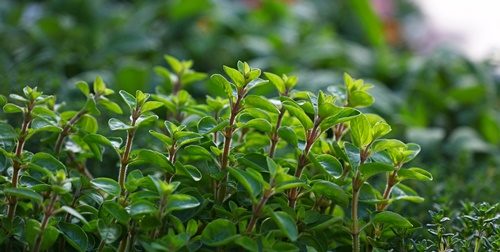
BASIL is an annual growing 12 to 15 inches high. It has many uses in soups, stews, and salads, but I like it best with tomatoes. One leaf or a part of one, according to your tastes, added to a quart of freshly stewed tomatoes or a combination of half tomatoes and half okra makes a dish fit for a king. Dried basil adds an important touch to many herb mixtures to be used as bouquets in little bags or mixed directly with the food during the cooking process. Basil has such a pleasant, spicy odor that I grow some in a box on the back porch so I can take a sniff every time I step out.
MINT is a whole family — spearmint, peppermint, apple mint, and orange mint; all are perennial, growing about 18 inches high. The mint leaf floating on a glass of lemonade and the mint sauce or jelly companion for lamb are well known, but did you ever eat minted peas or carrots or potatoes? Chop the fresh leaves very fine and sprinkle as little or as much as you like on the buttered vegetable. Candied mint leaves, glistening and sweet smelling, are a delightful confection. Wash and dry fresh mint leaves. Hold the stem in one hand while “painting” on both sides with egg white mixed with a little water; use a small, pencil-sized brush. Using a shaker, sprinkle with granulated sugar on both sides and lay on wax paper to dry.
DILL is fairly common in many gardens, where it generously produces seed to add zest to a wide variety of cucumber pickles. It’s a pity if you’ve never tasted sweet dills. This is the way I make them: Pack in an earthen jar alternate layers of washed grape and cherry leaves, heads of dill, and medium-sized cucumbers. Cover well with a brine made with 1 cup of salt to 5 quarts of water. Let stand two weeks and drain. Cut cucumbers in 1-inch pieces and pack in jars. For each quart make a sirup with 1 cup of vinegar, 2 cups of sugar, and 2 tablespoons of whole allspice. Pour boiling hot over cucumbers, and seal.
Dill seeds, about 1/2 teaspoon to 6 servings, are a nice addition to Harvard beets, and some folks sprinkle 10 or a dozen dill seeds over the apples in a pie. One tablespoon of fresh new dill leaves chopped very fine does something definite for a quart of potato salad, and 1 teaspoon of dill seeds to a quart of sauerkraut makes a “special” for our family.
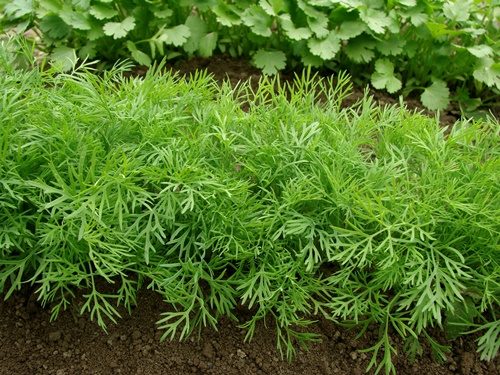
Dill is a self-sowing annual growing about 3 feet tall. It dies after the seeds are ripe, so it is best planted at the back of the garden where it can be cut down.
SUMMER SAVORY is another herb used more often in combination with other herbs than alone. It is especially good with beans, either fresh or dried. One half teaspoon of dried summer savory — or 1 tablespoon of fresh — added to 1 quart of fresh or canned string beans is a nice change from plain beans. The same amount adds a new flavor to a quart of lima beans or to our good old friend, bean soup.
Summer savory is a slender, graceful annual about 15 inches high. Plants should be 6 inches apart.
CARAWAY is the last of my list of kitchen herbs and I grow it for its flavorsome seeds. If you have never eaten caraway cookies, it is time you did. Just add 2 or 3 teaspoons of caraway seeds to your favorite lemon-flavored sugar-cooky dough and there you are! Braised cabbage, particularly red cabbage, with caraway seed is really good. For 1 pound of shredded cabbage, melt 2 tablespoons of butter, add 1/4 cup of brown sugar, 1/3 cup of vinegar, 1/2 teaspoon of caraway seed and finally the cabbage. Cook about 20 minutes, stirring often. Caraway seeds are sometimes added to rye bread and sauerkraut and they are not bad as a “munch” after meals. Beets are unusual and good if they have stood 1 hour in a hot marinade of 1 cup of vinegar, 1/3 cup of water, and 1 teaspoon of caraway seed.
Caraway is a biennial, so blooms and produces seeds the second year. Like dill, it self-sows, so after the first planting there will always be caraway plants in the garden. It grows about 2 feet high and plants should be pinched out so they stand about 12 inches apart.
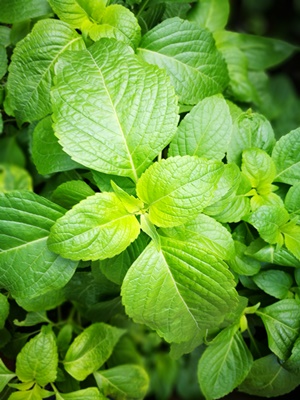
Garnishes and Combos
If we had used all the possibilities in the herb garden for garnishes, that clever, if not flattering, poem about “parsley, parsley everywhere” would never have been written! Chives, thyme, marjoram, basil, mint, dill, and caraway all have pretty foliage and make most attractive garnishes.
Each herb has many uses as an individual, but combinations of several herbs, especially the dried ones, add very intriguing and elusive flavors to many foods.
For Hamburger, Meatloaf, or Meatballs
- 1 tablespoon each of dried basil, celery, parsley, savory, sweet marjoram, and thyme
Mix well and store in an airtight container. Use 1/2 teaspoon of the mixture for each pound of ground beef for hamburgers; 1 teaspoon for each pound of meat for meat loaf containing bread crumbs or other “meat stretcher.”
For Tomato Soup or Juice
- 3 teaspoons basil
- 1 teaspoon each of celery leaves, parsley, thyme, and crumbled bay leaf
Mix thoroughly and make into soup bags by putting 1 heaping teaspoon of this mixture and a whole clove in the center of a 4-inch square of cheesecloth, gathering up the corners and tying with a white string. One bag will perk up about 2 quarts of tomatoes. Soup bags must be kept in an airtight container to retain their full flavor, and should not be used more than once.
Drying Herbs
Drying herbs in the air is easy and pleasant if certain precautions are observed. The right time for harvesting herbs for drying is just when the buds open into full flower. Then the leaves contain the largest amount of essential oils on which both flavor and fragrance depend. This period will be in August in most sections of the country.
Gather herbs for drying on a dry, clear morning as soon as the dew is gone. Discard any undesirable leaves and rinse off any dirt or sand. The leafy stems of the plants may be tied together and the bunches hung from cords stretched across a dry, fairly dark room with good cross ventilation.
Instead of drying in bunches, the fresh leaves may be stripped from the stems and spread in a thin layer on a drying frame made from a window screen covered with cheesecloth. This frame is propped up on the backs of chairs in the same dry, fairly dark room mentioned above. A warm attic is perfect.
In about a week the leaves should be crackly dry. Those dried on the stems should be stripped off and all rubbed through a coarse sieve and stored in airtight containers.
Be careful to keep each herb separate from the others and carefully labeled throughout the whole process because many of them look surprisingly, and dismayingly, alike when they are dried! And be sure the leaves are thoroughly dry before they are stored or they will mold. If the jars in which they are stored show signs of moisture on the inside, spread the contents out and allow to dry a few days longer.
Most herbs are dried in the air but you can dry parsley and celery leaves very satisfactorily in the oven. This is the way I do it: Pick leaves from the stems, wash, shake well, and drop into boiling salted water. Leave about half a minute until wilted, then lift the leaves out onto a fine wire screen (a piece of window screen), place on a flat pan such as a cooky sheet, and dry in a moderate oven with the door open for 10 to 20 minutes. A tightly packed quart of leaves will make about 1/3 cup of the dried product and you use it as any other dried herb — about 1/2 teaspoon for every tablespoon of fresh leaves.
7 General Guidelines for Cooking with Herbs
And now, may I give you a little general advice about using herbs in cookery?
- Be cautious, be very Start with small amounts, about half the amount suggested in the recipe.
- Be clever. Try herbs first in ground meat mixtures or in bags in soups or tomato juice so there will be no tell-tale bits to give you away.
- Be careful. Remember that 1/4 teaspoon of powdered herb equals 1/2 teaspoon of dried herb or 1 tablespoon of fresh herb. Recipes usually mean dried herbs unless they specify powdered, and fresh herbs are usually minced or chopped. Fresh herbs are always preferable.
- Be quiet. Don’t ask the family if they like herbs. They are sure to say “no,” families being what they are!
- Be discreet. Don’t serve herbs too often. Never more than 2 herb-flavored foods at one meal and those meals only occasionally unless you have a really adventurous family.
- Be patient. Little by little any family can be won over to the cheering section for herbs, at least a few herbs.
- Be happy. Enjoy growing herbs even if you don’t use them often in food. Walk among your herbs in the sunshine or after a rain or at twilight to enjoy their delectable fragrances, their lovely colors, and the unusual textures of their foliages, just as men and women have been doing for centuries.